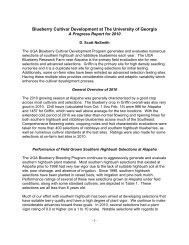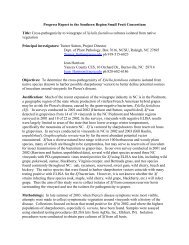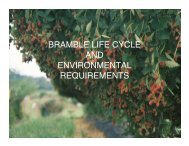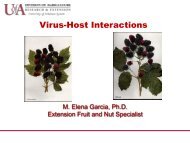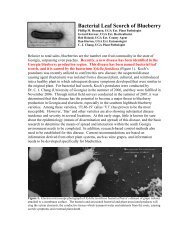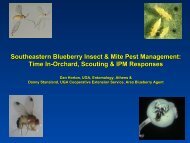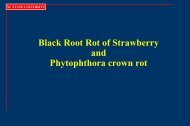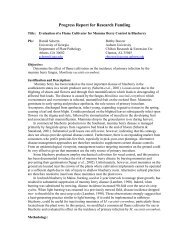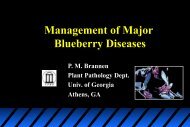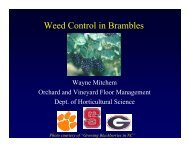Southeast Regional Blueberry Horticulture and Growth Regulator ...
Southeast Regional Blueberry Horticulture and Growth Regulator ...
Southeast Regional Blueberry Horticulture and Growth Regulator ...
Create successful ePaper yourself
Turn your PDF publications into a flip-book with our unique Google optimized e-Paper software.
flowers to set. The third <strong>and</strong> fourth sprays are directed toward the later blooming variety (i.e. ‘Tifblue’). The last ‘Woodard’ or ‘Climax’ flowers toopen will benefit from spray drift from ‘Tifblue’. The total applied during the season is normally 48-64 oz. acre.3. Apply gibberellic acid in about 40 gals. of water per acre. Since gibberellic acid activity is concentration-dependent (150 p.p.m. or greater activeingredient is best) at least 0.6 oz.of ProGibb should be used per gallon of finished spray (i.e. 24 oz. in 40 gal., 30 oz. in 50 gal., or 36 oz.in 60 gal.).4. Although common non-ionic surfactants can be used, it is recommended that X-77, Silwet L-77, Kinetic, or Flood be used with gibberellic acid.Follow label rates carefully. Silwet L-77 is used at the rate of only 3.2 oz./100 gal. of spray. Caution should be used in trying other surfactants,because they could burn blueberry blooms.5. In past years, only night applications of gibberellic acid were recommended. However, several experiments in 1995 showed comparable fruit setoccurred for both early day <strong>and</strong> night applications. In any case, it is best to apply gibberellic acid during periods of slow drying such as at night, inthe late evening or very early in the morning.6. Gibberellic acid should be compatible with most fungicides, but a small-scale trial is recommended to make sure settling or clabbering is not aproblem. The spray solution pH should be checked to make sure the pH is not too alkaline (pH 8.0 or above). If the pH is 8.0 or above, add abuffering agent.7. Do not apply within 40 days of harvest.8. If possible, do not apply if rain is forecast within 12 hours.9. Do not apply to bushes in a low state of vigor.10. Excessive applications may reduce flowering the following year by setting more fruit than the bush can properly mature. This is especially true ifthe bushes are in a low state of vigor. Do not apply to young bushes (i.e. 3 years old or less) since heavy fruiting may delay establishment.11. Some cultivars such as ‘Alapaha’, ‘Brightwell’ <strong>and</strong> ‘Powderblue’ usually set a good crop if planted with compatible cultivars for crosspollination. They seldom need applications of gibberellic acid unless bee activity is low or the blooms are damaged by spring freezes.12. Southern highbush blueberries often set more fruit than they can properly mature. Gibberellic acid can increase this problem.13. Part of the yield increase often seen with gibberellic acid is from smaller-sized, seedless or nearly seedless berries which ripen later in the season.If you are mechanically harvesting for the frozen market, this is not a problem, but it could pose a problem for h<strong>and</strong> picking of fresh fruit.





